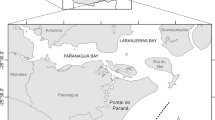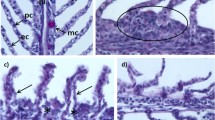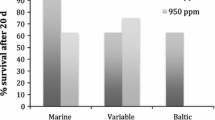Abstract
The narrow-clawed crayfish is a crayfish species that was accidentally introduced into the ecosystem of Lake Sevan in the 1980s. Soon it became one of the most preferred fisheries in the lake and an important link in the food chain by successfully replacing the endemic fish subspecies Sevan khramicarp (Capoeta sevangi, De Filippi, 1865) in the chain of detritivores. However, recently, the stock declines dramatically, associated with two main threats: the impact of burn-spot disease and an increase in fishing pressure on its population. To estimate the state of population under multiple stress conditions, we investigated the dynamics of stock, the size/age and sex structure, the fecundity, and the health status of the population. A comparative analysis of oxidative stress biomarkers (superoxide dismutase, catalase, glutathione-S-transferase activities and reduced glutathione, thiobarbituric acid reactive substance contents) showed significant differences between healthy and infected individuals. Another indirect effect of the disease, which probably leads to a decrease in the stock, was an increase in the proportion of immature females. Also, we observed some decrease in the infection rate along with the decline in the density of crayfish. However, stock reduction and some changes in the population may also be caused by a strong bloom of cyanobacteria.






Similar content being viewed by others
Availability of data and material
Not applicable.
Code availability
Not applicable.
References
Aebi, H. (1984). Catalase in vitro. Methods in Enzymology, 105, 121–126. https://doi.org/10.1016/S0076-6879(84)05016-3
Alekhnovich, A. V. (2014). Lifespan, growth and fecundity of narrow-clawed crayfish Astacus leptodactylus in Sominskoe Lake. Proceedings of the National Academy of Sciences of Belarus, 3, 80–88.
Aleksandrova, E. N. (2013). The brown-spot disease of Russian crayfish from the subfamily Astacinae Latreille, 1802 as an indicator of a current status of its population and quality of environment. Natural and Technical Sciences, 3, 79–83. (in Russian).
Asatryan, V., Stepanyan, L., Hovsepyan, A., Khachikyan, T., Mamyan, A., & Hambaryan, L. (2022b). The dynamics of phytoplankton seasonal development and its horizontal distribution in Lake Sevan (Armenia). Environmental Monitoring and Assessment, 194(10), 757. https://doi.org/10.1007/s10661-022-10446-5
Asatryan, V. L., Gambaryan, L. R., & Ghukasyan, E. K. H. (2022). Horizontal distribution of Lake Sevan phytoplankton biomass: Calculation method applying GIS technologies. In S. V. Berdnikov & V. V. Selyutin (Eds.), Scientific basis for the conservation and rehabilitation of Lake Sevan natural resources (pp. 323–332). Rostov-on-Don: SSC RAS Publishers. (in Russian).
Bradford, M. M. (1976). A rapid and sensitive method for the quantitation of microgram quantities of protein utilizing the principal of protein-dye binding. Analytical Biochemistry, 72, 248–254. https://doi.org/10.1016/0003-2697(76)90527-3
Budnikov, K. N. (1932). Crayfish, its harvesting and fishery (p. 209). Moscow: All Union United Cooperative Publishing House. (in Russian).
Buege, J. A., & Aust, S. D. (1978). Microsomal lipid peroxidation. Methods in Enzymology, 52, 302–310. https://doi.org/10.1016/S0076-6879(78)52032-6
Chevari, S., Chaba, I., & Sekei, I. (1985). Role of superoxide dismutase in cellular oxidative processes and the method of its determination in biological materials. Laboratornoe Delo, 11, 678–681. (in Russian).
Cìlbìz, M. (2020). Pleopodal fecundity of narrow-clawed crayfish (Pontastacus leptodactylus Eschscholtz, 1823). Invertebrate Reproduction & Development, 64(3), 208–218. https://doi.org/10.1080/07924259.2020.1762771
Edgerton, B. F., Henttonen, P., Jussila, J., Mannonen, A., Paasonen, P., Taugbøl, T., Edsman, L., & Souty-Grosset, C. (2004). Understanding the causes of disease in European freshwater crayfish. Conservation Biology, 18(6), 1466–1474. http://www.jstor.org/stable/3589027
Evans, L. H., & Edgerton, B. F. (2002). Pathogens, parasites and commensals. In D. M. Holdich (Ed.), Biology of freshwater crayfish (pp. 377–438). Blackwell Science Ltd.
Gabrielyan, B., Khosrovyan, A., & Martin, S. (2022). A review of anthropogenic stressors on Lake Sevan, Armenia. Journal of Limnology, 81(s1), 2061. https://doi.org/10.4081/jlimnol.2022.2061
Gevorgyan, G., Rinke, K., Schultze, M., Mamyan, A., Kuzmin, A., Belykh, O., Sorokovikova, E., Hayrapetyan, A., Hovsepyan, A., Khachikyan, T., Aghayan, S., Fedorova, G., Krasnopeev, A., Potapov, S., & Tikhonova, I. (2020). First report about toxic cyanobacterial bloom occurrence in Lake Sevan, Armenia. International Review of Hydrobiology, 105(5–6), 131–142. https://doi.org/10.1002/iroh.202002060
Ghukasyan, EKh., Melkonyan, H. F., Stepanyan, L. G., & Badalyan, N. S. (2019). The features of narrow-clawed crayfish (Pontastacus leptodactylus Eschscholtz, 1823) population development in Lake Sevan during 1996–2018. Ecosystem Transformation, 2(3), 24–31.
Habig, W. H., Pabst, M. J., & Jakoby, W. B. (1974). Glutathione S-transferases: the first enzymatic step in mercapturic acid formation. Journal of Biological Chemistry, 249(22), 7130–7139.
Hambaryan, L. R., Stepanyan, L. G., Mikaelyan, M. V., & Gyurjyan, Q. G. (2020). The bloom and toxicity of cyanobacteria in Lake Sevan. Proceedings of the YSU B: Chemical and Biological Sciences, 54(2), 168–176. https://doi.org/10.46991/PYSU:B/2020.54.2.168
Hovhannisian, R., & Ghukasyan, E. (1996). Some ecological peculiarities of Lake Sevan Higher Crustacea, Pontastacus Leptodactylus Esch. In Lake Sevan: Problems and strategies of action. Proceedings of the international conference (pp. 99–101). Armenia: Sevan.
Hovhannisyan, R. H., & Ghazaryan, I. A. (1986). Succession of phytoplankton community during different periods of Lake Sevan water level lowering. In Abstracts of the 1st congress of hydrobiologists of Moldova (105–106). Kishinev. (in Russian).
Ivankov, V. N. (1985). Fecundity of fish: Methods of investigation, variability, patterns of formation (p. 88). Vladivostok: Far East University Publishing House. (in Russian).
Longshaw, M. (2011). Diseases of crayfish: A review. Journal of Invertebrate Pathology, 106(1), 54–70. https://doi.org/10.1016/j.jip.2010.09.013
Makkonen, J., Jussila, J., Koistinen, L., Paaver, T., Hurt, M., & Kokko, H. (2013). Fusarium avenaceum causes burn spot disease syndrome in noble crayfish (Astacus astacus). Journal of Invertebrate Pathology, 113(2), 184–190. https://doi.org/10.1016/j.jip.2013.03.008
Møller, P., Wallin, H., & Knudsen, L. E. (1996). Oxidative stress associated with exercise, psychological stress and life style factors. Chemico-Biological Interactions, 102, 17–36. https://doi.org/10.1016/0009-2797(96)03729-5
Moron, M. S., Depierre, J. W., & Mannervik, B. (1979). Levels of glutathione, glutathione reductase and glutathione S-transferase activities in rat lung and liver. Biochimica Biophysica Acta, 582(1), 67–78. https://doi.org/10.1016/0304-4165(79)90289-7
Morozov, A. A., Chuiko, G. M., & Brodskii, E. S. (2012). Functional state of the liver antioxidant system of the bream Abramis brama (L.) from Rybinsk Reservoir regions with different anthropogenic loads. Inland Water Biology, 5(1), 147–152. https://doi.org/10.1134/S1995082911040134
Owen, L. S., Rudneva, I. I., & Shevchenko, N. F. (2000). Responses of Scorpaena porcus (Scorpaenidae) to anthropogenic impact. Journal of Ichthyology, 40(1), 70–73.
Pravdin, I. (1966). Fish study guide. Moscow, 376 (in Russian).
Richman, N. I., Böhm, M., Adams, S. B., Alvarez, F., Bergey, E. A., Bunn, J. J. S., Burnham, Q., Cordeiro, J., Coughran, J., Crandall, K. A., Dawkins, K. L., Di Stefano, R. J., Doran, N. E., Edsman, L., Eversole, A. G., Füreder, L., Furse, J. M., Gherardi, F., Hamr, P., & Collen, B. (2015). Multiple drivers of decline in the global status of freshwater crayfish (Decapoda: Astacidea). Philosophical Transactions of the Royal Society B: Biological Sciences, 370, 1662. https://doi.org/10.1098/rstb.2014.0060
Rudneva, I. I. (2003). Ecological and physiological characteristics of the antioxidant system of fish and lipid peroxidation processes. Russ Modern Biology, 123(4), 391–400. (in Russian).
Sakharova, E. G., Krylov, A. V., Sabitova, R. Z., Tsvetkov, A. I., Hambaryan, L. R., Mamyan, A. S., Gabrielyan, B. K., Hayrapetyan, A. O., & Khachikyan, T. G. (2020). Horizontal and vertical distribution of phytoplankton in alpine Lake Sevan (Armenia) during the summer water blooms of Cyanoprokaryota. Contemporary Problems of Ecology, 13(1), 60–70.
Salafsky, N., Salzer, D., Stattersfield, A. J., Hilton-Taylor, C., Neugarten, R., Butchart, S. H., Collen, B., Cox, N., Master, L. L., O’Connor, S., & Wilkie, D. (2008). A standard lexicon for biodiversity conservation: Unified classifications of threats and actions. Conservation Biology, 22(4), 897–911. https://doi.org/10.1111/j.1523-1739.2008.00937.x
Shields, J. D. (2012). The impact of pathogens on exploited populations of decapod crustaceans. Journal of Invertebrate Pathology, 110(2), 211–224. https://doi.org/10.1016/j.jip.2012.03.011
Strayer, D. L., & Dudgeon, D. (2010). Freshwater biodiversity conservation: Recent progress and future challenges. Journal of the North American Benthological Society, 29(1), 344–358. https://doi.org/10.1899/08-171.1
Wilkinson, I. P. (2020). Lake Sevan: Evolution, biotic variability and ecological degradation. In S. Mischke (Ed.), Large Asian lakes in the changing world (pp. 35–63). Springer International Publishing. https://doi.org/10.1007/978-3-030-42254-7_2
Yu, W., Cestti, R. E., & Lee, J. Y. (2015). Toward integrated water resources management in Armenia (p. 177). Washington: The World Bank. https://doi.org/10.1596/978-1-4648-0335-2
Zenkov, N. K., Lankin, V. Z., & Men’shchikova, E. B. (2001). Oxidative stress: Biochemical and pathophysiological aspects (p. 343). Moscow: Nauka. https://doi.org/10.1155/2020/2082145
Acknowledgements
The authors want to thank the “Hydrometeorology and Monitoring Center” (HMC) SNCO of the Ministry of Environment for the provision of hydrochemical observation database for Lake Sevan.
Funding
The work was supported by the Science Committee of RA, in the frames of the research project № 21T-1F183.
Author information
Authors and Affiliations
Contributions
All the material of crayfish was sampled and processed by Evelina Ghukasyan and Norik Badalyan. Biochemical analysis was performed by Hranush Melkonyan. Hydro-chemical data analysis was performed by Gayane Shahnazaryan. Statistical analyses and data interpretation was realized by Vardan Asatryan. The first draft of the manuscript was written by Vardan Asatryan, Evelina Ghukasyan, Hranush Melkonyan and Bardukh Gabrielyan. All authors commented on previous versions of the manuscript. All authors read and approved the final manuscript.
Corresponding author
Ethics declarations
Competing interests
The authors declare no competing interests.
Disclaimer
All authors have read, have understood, and have complied as applicable with the statement on “Ethical responsibilities of Authors” as found in the Instructions for Authors.
Additional information
Publisher's Note
Springer Nature remains neutral with regard to jurisdictional claims in published maps and institutional affiliations.
Rights and permissions
Springer Nature or its licensor (e.g. a society or other partner) holds exclusive rights to this article under a publishing agreement with the author(s) or other rightsholder(s); author self-archiving of the accepted manuscript version of this article is solely governed by the terms of such publishing agreement and applicable law.
About this article
Cite this article
Ghukasyan, E., Asatryan, V., Melkonyan, H. et al. The state of the population of narrow-clawed crayfish in Lake Sevan (Armenia) under multiple stress conditions. Environ Monit Assess 195, 1278 (2023). https://doi.org/10.1007/s10661-023-11921-3
Received:
Accepted:
Published:
DOI: https://doi.org/10.1007/s10661-023-11921-3




